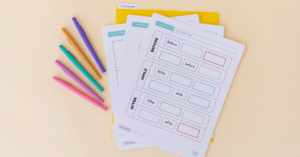This is a guest blog post by Monica, a school-based SLP, all about how to support Sensory Needs.
Part of being neurodiversity affirming is recognizing that students who have sensory needs may not be able to regulate themselves or identify what their sensory needs are. What may have been traditionally seen as “noncompliance” can now be viewed through this lens. We can help support our students instead of requiring them to mask their needs. One thing to keep in mind is that students don’t know what they don’t know. It’s one of my favorite phrases that I learned from a fellow SLP. Students may not be aware that they have sensory preferences or how to advocate for themselves. They may not know that they are dysregulated or what would help. Even as adults, we have a hard time listening to our bodies, for example, sometimes remembering to eat or drink. I can’t imagine how hard it is for a neurodivergent child!
It is crucial to create an environment where students can be themselves and get their needs met. Masking and unmet support needs are highly correlated with higher rates of suicide and later mental health issues (Cassidy et al., 2018).
Jessie Ginsburg on Instagram is an excellent resource for what to look out for and tips for working with our students.
When talking about sensory needs and stimming, it’s easier to explain to others as if you were the student. Think about the itchiest bug bite you’ve ever had and how much you felt like you needed to scratch it. You can’t think about anything else because it’s so itchy. Sometimes that’s what having a sensory need feels like, and itching it would be stimming. When you ask students not to stim, or don’t give them an alternative, what you’re asking them to do is listen to you and follow your directions while all they can think about is how uncomfortable they feel. Just like how scratching a bug bite is the only thing that would make you feel better, the way a student prefers to stim may be the only thing that would help them self-regulate. Keep that in mind when alternatives to stimming are suggested. Listening to my students and their sensory needs is essential to building trust because most of my caseload is autistic or has sensory needs.
Quick Ways to Adjust Your Sessions
Give students a choice to sit or stand, as long as they are being safe.
Put a band on the chair legs so that they can move their legs while they sit.
Have an inflated wobble cushion.
Give movement breaks if they are sitting for a long time. Have them stretch in place or give themselves a hug.
Movement breaks with a preferred activity. A lot of my students love dancing to songs. I keep in mind what may be too much sensory input.
Practicing asking for accommodations during a session is a great way to practice self-advocacy skills as well! I start by experimenting with the different supports, then give them a choice of 2-3, tell them they need to ask, then wait for them to ask independently.
Other Things to Keep in Mind
Smells: If I could suggest one easy thing, it would be to not have any strong scents in the classroom and speech room.
Lighting: Is your speech space too bright? Some students may do better without bright overhead lighting. Try turning the lights off (if you can!) or adjusting the lighting to see if it makes a difference.
Sounds: I ask students if the music is too loud, and we adjust as needed. It’s also a great opportunity to practice self-advocacy.
References
Cassidy, S., Bradley, L., Shaw, R., & Baron-Cohen, S. (2018). Risk markers for suicidality in autistic adults. Molecular Autism, 9, 42.




Reader Interactions